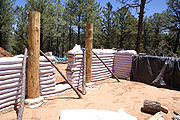
Nader Khalili
Encyclopedia

In 1970 he was licensed by the State of California and practiced architecture in the U.S. and around the world. Khalili was known for his innovation into the Geltaftan Earth-and-Fire System known as Ceramic Houses
Ceramic houses
Ceramic houses are buildings made of an earth mixture which is high in clay, and fired to become ceramic. The process of building and firing such houses was developed by Iranian architect, Nader Khalili, in the late 1970s. he named it Geltaftan; "Gel", means "clay", and "taftan", means "firing,...
and the Earthbag Construction
Earthbag construction
Earthbag construction is an inexpensive method to create structures which are both strong and can be quickly built. It is a natural building technique that evolved from historic military bunker construction techniques and temporary flood-control dike building methods...
technique called Superadobe. His designs are heavily inspired by traditional arid house designs in his homeland Iran. He was involved with Earth Architecture and Third World Development since 1975, and was a U.N. consultant for Earth Architecture.
He developed his Super Adobe system in 1984, in response to a NASA
NASA
The National Aeronautics and Space Administration is the agency of the United States government that is responsible for the nation's civilian space program and for aeronautics and aerospace research...
call for designs for human settlements on the Moon and Mars. The project had been completely theoretical until the Persian Gulf War when refugees were sent into Iran. When this occurred Khalili partnered with the United Nations Development Programme
United Nations Development Programme
The United Nations Development Programme is the United Nations' global development network. It advocates for change and connects countries to knowledge, experience and resources to help people build a better life. UNDP operates in 177 countries, working with nations on their own solutions to...
(UNDP) and the United Nations High Commissioner for Refugees
United Nations High Commissioner for Refugees
The Office of the United Nations High Commissioner for Refugees , also known as The UN Refugee Agency is a United Nations agency mandated to protect and support refugees at the request of a government or the UN itself and assists in their voluntary repatriation, local integration or resettlement to...
(UNHCR) and applied his research to emergency shelters.
In 1991 he founded the California Institute of Earth Art and Architecture (Cal-Earth), where he taught his Superadobe building technique. Although Khalili's work received mixed support in his native country, arguably due to social paradigms and political unrest, he became a prominent American leader on the value of ethically based architecture, where the needs of the homeless are considered above all else.
Khalili wrote books on his architectural philosophy & techniques as well as translations of poetry from Rumi, the poet he considered instrumental in his design inspiration.
Nader Khalili died on Wednesday, March 5, 2008.
Awards
In 1984, Khalili received the award for “Excellence in Technology” from the California Council of the American Institute of Architects (CCAIA) for his innovation of the Ceramic House System. In 1987 he received a Certificate of Special Recognition from the U.N. International Year of Shelter for the Homeless and U.S. Department of Housing and Urban Development (HUD) for his project "Housing for the Homeless: Research and Education." In 2004 Khalili won the Aga Khan Award for ArchitectureAga Khan Award for Architecture
The Aga Khan Award for Architecture is an architectural prize established by Aga Khan IV in 1977. It aims to identify and reward architectural concepts that successfully address the needs and aspirations of Islamic societies in the fields of contemporary design, social housing, community...
for Superadobe.
External links
- Khalili, Nader. "Nader Khalili." Cal-Earth. 19 Jan. 2007 http://www.calearth.org/khalili.htm
- Katauskas, Ted. "Dirt-Cheap Houses from Elemental Materials." Architecture Week. Aug. 1998. 19 Jan. 2007 http://www.architectureweek.com/2000/0517/building_1-1.html
- Husain, Yasha. "Space-Friendly Architecture: Meet Nader Khalili." Space.com. 17 Nov. 2000. 19 Jan. 2007 http://www.space.com/peopleinterviews/khalili_profile.html
- Sinclair, Cameron, and Kate Stohr. "Superadobe." Design Like You Give a Damn. Ed. Diana Murphy, Adrian Crabbs, and Cory Reynolds. Ney York: Distributed Art Publishers, Inc., 2006. 104-13.
- Kellogg, Stuart, and James Quigg. "Good Earth." Daily Press. 18 Dec. 2005. Freedom Communications, Inc. 22 Jan. 2007 http://www.vvdailypress.com/2005/113489280061585.html
- Alternative Construction: Contemporary Natural Building Methods. Ed. Lynne Elizabeth and Cassandra Adams. New York: John Wiley & Sons, Inc., 2000.
- Hunter, Kaki, and Donald Kiffmeyer. Earthbag Building. Gabriola Island, BC: New Society Publishers, 2004.
- Kennedy, Joseph F. "Building With Earthbags." Natural Building Colloquium. NetWorks Productions. 14 Feb. 2007 http://www.networkearth.org/naturalbuilding/earthbags.html
- Aga Khan Development Network. "The Aga Khan Award for Architecture 2004." Sandbag Shelter Prototypes, various locations. 14 Feb. 2007 http://www.akdn.org/agency/akaa/ninthcycle/page_03txt.htm
- The Green Building Program. "Earth Construction." Sustainable Building Sourcebook. 2006. 14 Feb. 2007 http://www.austinenergy.com/Energy%20Efficiency/Programs/Green%20Building/Sourcebook/earthConstruction.htm
- NBRC. "NBRC Misc. Photos." NBRC: Other Superadobe Buildings. 10 Dec. 1997. 14 Feb. 2007 http://users.pstel.net/goshawk/other.htm
- CCD. "CS05__Cal-Earth SuperAdobe." Combating Crisis with Design. 20 Sept. 2006. 14 Feb. 2007 http://combatingcrisiswithdesign.blogspot.com/2006/09/cs05cal-earth-superadobe.html
- American Institute of Architects. A Conversation with Nader Khalili. 2004. 14 Feb. 2007 http://www.aia.org/nwsltr_print.cfm?pagename=aiaj_a_20051201_khalili

